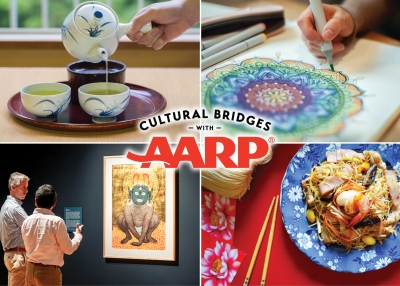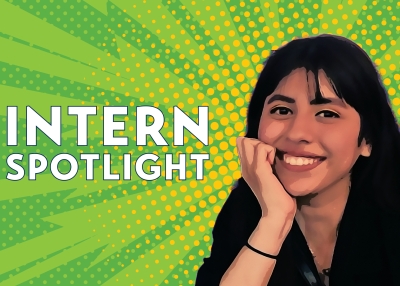Filipinx Artists from Three Coasts Reflect on New Perspectives, Practices during Lockdown
Asia Society at Home
Learn More
HOUSTON, August 11, 2020 — In conversation on Tuesday, June 16, 2020, Asia Society Texas Center welcomed three Filipinx artists from different coasts across the United States to reflect on new perspectives and practices during lockdown. Jeanne F. Jalandoni, a New York-based artist working primarily in paint and textile, Houston-based artist and community organizer Matt Manalo, and interdisciplinary artist Charlene Tan working from San Francisco addressed topics from their shifting priorities to their use of textiles in a live-streamed conversation. Bridget Bray, Nancy C. Allen Curator and Director of Exhibitions, joined Jalandoni, Manalo, and Tan as moderator.
Working in a new reality
All three artists began by reflecting on how they’ve had to adapt their practices to the physical and social isolation of shelter-in-place orders. With work including painting, drawing, sculpture, photography, and printmaking as well as social practice, Manalo said he has found it challenging to produce more personal pieces over the last several months in his home studio space. Jalandoni and Tan reflected on scale, both having moved from practicing in a studio context to in their homes. While both hope in the future to increase the scale of the art they produce, at the moment they have shifted to productions that can fit the size of the space they currently occupy.
Textiles in artistic practice
When her studio closed and she no longer had access to the large-scale loom she had been working with, Jalandoni began to produce face masks using batik material from the Philippines. She said the practice helped her to generate ideas around the cultural meaning of these patterns, and her research into the fabric’s presence across different regions has shaped her thinking on upcoming projects.
Jalandoni also reflected upon her integration of fabric into her painting. She noted how shifting from painting textiles to incorporating them into her pieces helped her create a multidimensional approach, giving her the flexibility to challenge the viewer over what is real and what isn’t, what has value and meaning, and why.
Tan’s work with fabric has also interrogated the interweaving of identity and food culture. For her series featured in Asia Society’s Super Sarap exhibition, this manifested as an almost anthropological study of the visual language of the textiles from the Philippines. As a Filipina-Chinese-American, Tan said she wanted to explore her identity through familiar materials, in this case utilizing products she could only find in Filipino or Chinese grocery stores, including tapioca and ube powder. These materials are then used to recreate a unique visual artifact of her heritage in the form of tribal weaving.
Manalo began by using textiles as a form of necessity in art school, repurposing the materials he could find and engaging his community in helping him to source fabric for his work. This brought him into contact with a variety of textiles that he uses to build layers into his work. Focusing on the rawness of materials, he said he sees these pieces as a form of self-portrait. The materials are not pretending to be anything else, and anything he does to modify this rawness is a reflection of his current experience — for example, works that involve an object being painted over could reflect that he himself was dealing with topics such as censorship or whitewashing.
Artistic practices in new pressures
All three artists discussed community uniting in the face of uncertainty, both in how artists are processing communal and economic loss due to restrictions surrounding COVID-19, as well as navigating complex social issues arising out of social justice movements.
For Manalo, two manifestations of his social practice, Filipinx Artists of Houston and Alief Art House, are a central focus for him during these times. Both came out of a feeling of emptiness over 10 years of navigating through art spaces and not finding others who looked like him. Working with community gave him a new sense of fulfillment, and his artistic priorities have focused on contributing to community projects and furthering social justice issues.
Manalo said he considers it more important than ever that people are starting their own initiatives to show work, and that museums are trying to change their practices to be more accessible to those who haven’t had access before. In contributing to other’s projects as well as working with his own initiatives, Manalo is focusing on amplifying the voices of artists who have not been included historically.
Jalandoni commented on the heavy impact the current movement is having on artists. She said she hopes for a long-overdue shift in art patrons requesting to see more and expanded work in museums and galleries, and feels that people are questioning more whose art is being seen and where. Having always addressed racial injustice in her work through the lenses of colonialism and imperialism, she has spent much of her time recently taking a pause to consider the nuance of her own position within a larger movement — particularly in the understanding of colorism in different cultures and the nuances of issues of privilege.
Tan indicated the personal toll of examining deep issues within her community has been mixed in with her artistic process, and that an artistic response to the current social movement by necessity needs to reflect what's going on. She said she prefers to allow time to consider how that should manifest. With conversations happening in family and community, emotional exhaustion can be on outgrowth of trying to figure out how to respond artistically and Tan has been intentional in considering her next steps.
How can the public concretely support artists during this time?
In response to an audience question, all three artists indicated the purchase of artwork is always an essential way to support artists, even if the purchase isn’t expensive. They also advocated for audiences attending smaller shows in less-established galleries and museums, and showing support for artists by showing up in person when possible and online. Finally, they emphasized finding and connecting with your own communities during these times, to find support and solace in the shared experience.
Connect with the Artists
Jeanne F. Jalandoni
Website: Jeannefjalandoni.com
Instagram: @jfjalandoni.art
Matt Manalo
Website: http://www.mattmanalo.com/
Instagram: @mattmanalo
Charlene Tan
Website: http://charlene-tan.com/index.php?/cv/
Instagram: @char.art.tan
Business and Policy programs are endowed by Huffington Foundation. We give special thanks to Bank of America, Muffet Blake, Anne and Albert Chao, ConocoPhillips, ExxonMobil, Nancy Pollok Guinee, and United Airlines, Presenting Sponsors of Business and Policy programs; Nancy C. Allen, Chinhui Juhn and Eddie Allen, and Leslie and Brad Bucher, Presenting Sponsors of Exhibitions; Dr. Ellen R. Gritz and Milton D. Rosenau, Presenting Sponsors of Performing Arts and Culture; Wells Fargo, Presenting Sponsor of Education & Outreach; and Mitsubishi Corporation (Americas), Presenting Sponsor of the Japan Series. General support of programs and exhibitions is provided by The Brown Foundation, Inc., The Hearst Foundation, Inc., Houston Endowment, Inc., the City of Houston through Houston Arts Alliance, McKinsey & Company, Inc., National Endowment for the Arts, Texas Commission on the Arts, Vinson & Elkins LLP, and Mary Lawrence Porter, as well as Friends of Asia Society.
About Asia Society at Home
We are dedicated to continuing our mission of building cross-cultural understanding and uplifting human connectivity. Using digital tools, we bring you content for all ages and conversations that matter, in order to spark curiosity about Asia and to foster empathy.
About Asia Society Texas Center
With 13 locations throughout the world, Asia Society is the leading educational organization promoting mutual understanding and strengthening partnerships among the peoples, leaders, and institutions of Asia and West. Asia Society Texas Center executes the global mission with a local focus, enriching and engaging the vast diversity of Houston through innovative, relevant programs in arts and culture, business and policy, education, and community outreach.





